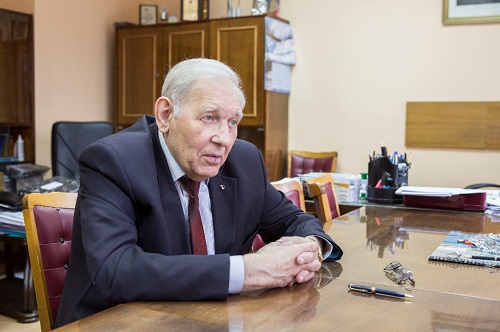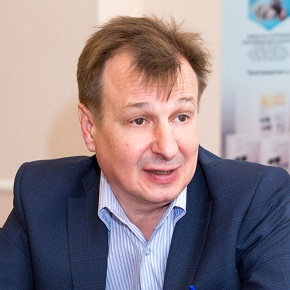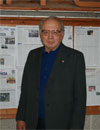 |
||
|
Vladimir Poplavsky: It is Too Early to Compare Lead to Sodium AtomInfo.Ru, PUBLISHED 13.08.2016 In his interview, the leading Russian specialist in fast reactors, Doctor of Engineering Science, Professor, Deputy Director General at the Institute for Physics and Power Engineering, Vladimir Poplavsky told Olga Ganzhur about the unique facts from the history of sodium technologies development and explained his concerns about the BN-1200 project destiny. CONTINUED BELOW Vladimir Poplavsky, (c) IPPE  Not long ago I read an article called "The Future of Fast Reactors" that was published by Leypunsky and Kazachkovsky in the "Atomic Energy" journal in1962. Actually, common people may have the impression that the concept of fast nuclear power had already been worked out by that time. But in reality, how big is the progress made by the science within these 50 years? As far back as in1949, Alexander Ilyich Leypunsky submitted to the Government an internal report in which he stated the fast technology potential in terms of nuclear fuel breeding; afterwards these ideas formed the basis for the concept of fast reactors. To a large extent, this concept is still very topical nowadays and not only in Russia. By 1962 a certain experience had been gained in the area of sodium technologies and fast reactors on the whole. The experimental BR-5 reactor remained the main source of information in the field of fast reactors in the Soviet Union. The strategy of nuclear power development with the use of fast reactors was approved by the Government and supported by the Ministry of Medium Machine-Building; the time came to think about further development. The task was set out to move from the experimental BN-5 reactor to a demonstrational one that could have all the functions of a power unit and, first of all, a high capacity. Thus, by 1962 the scientists had experimentally proved that a fast reactor could really achieve the fuel breeding gain value higher than 1, which is the principal fundamental property of the fast reactor. However, at that time there was no technical justification of feasibilities to construct an NPP with a fast reactor. We realized physical, thermo-hydraulic, engineering fundamentals of the technology but at the experimental level only. In this context, the first experience was only gained in the early 70-s at the BN-350. And that experience was of crucial importance as it demonstrated both positive and negative aspects of the technology. What does it mean? At that time there were wide gaps in our knowledge and we could not simultaneously develop two areas: reactor and fuel. So the decision was made to postpone the solution of fuel problems and concentrate our efforts on reactor construction; development of the mixed uranium-plutonium fuel typical of fast reactors was postponed for a while. The BN-350 commissioning and the first experience of its operation showed that the core materials were subject to radiation deformation and this fact should be taken into account in the core design. We used a steam generator with a single-wall separation of sodium coolant and water. Sodium behavior with regard to structural materials is extremely noble, however, it is chemically reactive in relation to air oxygen and water. We feared leakages, and it was not groundless. And the cause was in a poor quality of the steam generator rather than in its design deficiency. That equipment was produced for the first time, and at that moment there were no such methods of nondestructive assay as we have today. Having seen the consequences of sodium-water reaction, we came to a very important conclusion: steam generators required specific attention from the point of view of timely detection of water leak into sodium; a steam generator should be protected with a special system. Despite all the difficulties in its mastering, on the whole, the BN-350 reactor turned out very important in the context of BN-600 reactor justification. The BN-600 reactor was started up five years later than the scheduled date; and during that time we managed to eliminate all the drawbacks that were revealed in that technology at the BN-350 reactor. We actually redesigned two main elements of a nuclear power plant: its core and steam generator. The BN-600 reactor has been in operation for 36 years and it operates very well, whereas actually all the other fast power reactors in the world have been shut down, for different reasons, both technical (expired lifetime) and political. No doubt, the BN-600 reactor also has some deficiencies, but just due to that, by the year of 2000 we had got almost the entire spectrum of emergency conditions possible at fast reactors and learnt how to repair all the systems. So, in 2000, after 20 years of successful BN-600 operation, we firmly declared that sodium cooled fast reactor had been justified in terms of its safety and operability. However, its competitive capacity and economic parameters are not as good…At the beginning they were not as important. Currently we are facing the challenge to achieve competitive engineering and economic characteristics of the NPP with a fast reactor, keeping the same safety level and even enhancing it. Why after the BN-600 reactor did they start BN-800 construction? Why do we need it? The background of this project is very complicated; it is related to certain macro-economic and political processes that took place in our country in the period when the BN-800 was under development and construction. A fast reactor is multifunctional. Actually we are talking about a duel use technology. In the mid-70-s the decision was made to design a fast sodium reactor for specific purposes (BNK project). However, the further course of events in the industry showed that there was no need in that special system. In compliance with the decision made by the Ministry of Medium Machine-Building (and personally by Yefim Pavlovich Slavsky), the project was redesigned; the new objective was to construct a fast power reactor with improved (as compared to BN-600) characteristics, i.e. BN-800. It is based on many technical solutions that were used in BN-600, but there are also significant differences. The index of metal intensity is 30?% better for this reactor as compared to BN-600. In terms of the safety issues solutions, it also differs significantly from the BN-600 reactor. For the first time we used passive reactivity control rods, introduced additional devices to improve safety. The work on this reactor design began as far back as in the 70-s, but the reactor was commissioned not long ago. Why? The BN-800 should have been commissioned soon after the BN-600 start-up. In 1983 the Order of the Central Committee of the Communist Party of the Soviet Union and the Council of Ministers was issued to construct four BN-800 units: three at the South-Ural NPP site and one at the Beloyarsk NPP site. At the South-Ural NPP site the foundation pit was even excavated fir the first unit, and the entire auxiliary infrastructure was set up. At the Beloyarsk site the work was also started. But then, in the early 90-s everything was stopped and suspended, and up to 2005 there were only words and no deeds. We knew that the BN-600 operation was successful, but the designers and scientists had the potential that was not used to the full extent. At that time, if we did not solve new tasks, we would lose the technology completely. We would say that BN-800 was just a very good tool to pave the way for making the nuclear fuel cycle closed in the nuclear power. Unfortunately, the Minatom potential turned out insufficient to resume the BN-800 construction. And we had to address the State Duma (the Lower House of Russian Federation Parliament), to the Committee for Energy, Transport and Communication to get their support. That was the time when the Federal Target Program for Nuclear Power Industrial Complex Development was under preparation. The .decision was made that the State would allocate considerable matching funds for the construction of each power unit from the state budget. As far as BN-800 construction was concerned, we managed to prove that its construction should be completely performed for the budget funds. Unfortunately, based on the BN-800 experience we learned the lessons of what are the wrong ways to construct an NPP. Because of the delay in the construction work, we lost a lot. The industrial base that had been set up for the BN-600 construction was no more unavailable, the human capacity became much lower. Thus, many problems had to be solved all over again. Can you imagine what it meant for the Beloyarsk site to establish a new construction base? Actually, the equipment manufacturing plants lost their process technologies. For example, we used to have our domestic sodium coolant: for the BN-350 reactor sodium was produced in Chirchiq, for the BN-600 reactor- in Berezniki, the Urals. In the course of preparation for BN-800 construction in the 90-s, a special system to produce reactor-grade sodium was constructed in Usolye-Sibirskoye, close to Irkutsk. The manufacturers had been waiting for a long time when we would need sodium, and we kept on say, "Tomorrow, tomorrow, tomorrow…" Finally they gave in and closed their production site. Currently, under the conditions of market economy, who would keep a production unit if it is not needed to anyone? Eventually, we got sodium from France. Fortunately, all the problems have been solved by now, at a high price though. The successful implementation of the BN-800 project, whose development, justification and construction were performed with great difficulties, under the conditions of social and economic restructuring of the country, can be considered a real labor feat of the scientists, designers, architect-engineers, construction and iron workers, and operation personnel. In spite of a long delay in its commissioning, will the reactor be in demand? The BN-800 reactor is destined to have a long and busy life. In particular, it is necessary to develop and master the technology of mixed uranium-plutonium fuel at the pilot level, to develop the technology of SNF and RAW management. However, it is only a prelude to the achievement of the final goal: to change nuclear power of the country over to the closed fuel cycle. In the long run, nuclear power of Russia should become a two-component structure consisting of thermal and fast reactors. At the same time, reactors should perform a backbone function with regard to other components of the fuel cycle and have acceptable technical and economic features. However, whereas thermal neutron reactors have achieved the commercial level (VVER-1000, VVER -1200, VVER -TOI projects), sodium-cooled fast reactors have not reached this level yet. In view of that, the task has arisen to develop a project of fast neutron reactor that could have even more improved technical and economic parameters as compared to BN-600 and BN-800 reactors. In March 2001, actually under conditions of absolutely no work on fast sodium reactors, at the initiative of the IPPE top management, this question was considered at Science and Technology Council (STC) meeting No.1 in Minatom and the decision was made to start the R&D work on the development of large-power fast neutron reactor with commercial characteristics. At the first stage the Scientific Supervisor (IPPE), Chief Designer (OKBM) and General Designer (SPBAEP) together developed technical proposals on the power unit with BN-1800 reactor. Further optimization of the power unit parameters resulted in the solution about the expedience to reduce its electric capacity to 1200 MW. The BN-1200 project was based on design, engineering, circuit and lay-out solutions that in some aspects were fundamentally different as compared to the BN-600 and BN-800 projects. First of all, it concerns safety systems (making use of passive devices to control reactivity in the core and decay heat removal), reactor core, transport flow chart and steam generator. Altogether the approved engineering and technical solutions made it possible to reduce almost 2.5 times the specific consumption of materials for this reactor as compared to BN-600. On the whole, in terms of its investment cost the BN-1200 project has become much closer to the VVER-TOI project. Soon the destiny of the BN-1200 project will be determined: to build or not to build. As far as I know, last year at the ROSATOM STC meeting the problem was posed for scientists, designers and architect engineers to further improve technical and economic design parameters. Was this problem solved? You are right; at the STC meeting consideration was given to a substantial expert evaluation that showed that there were still some reserves and margins to enhance technical and economic characteristics. We developed an Action Plan, by the end of the year we will have proposed a number of new technical solutions. However, unfortunately, I am not sure that they will significantly influence the decision about the BN-1200 reactor unit construction. Currently the situation starts resembling the BN-800 story. What is behind your concern? Do you think a new Federal Target Program (FTP) on the advanced nuclear technologies will not be approved? The new FTP may be approved, but there is a risk that the BN-1200 project, like it happened to BN-800, will be placed on hold. The BN-1200 project in the industry is currently opposed to the BR-1200 project - a lead reactor. Many representatives of the top management consider that all the efforts and funds should be concentrated on its development as in terms of some characteristics it should outperform and beat sodium reactors. But I have been in the fast reactor area for 55 years, and I realize very well that to master the technology of this scale is a very complicated and long-term process. Of course, we need to construct BREST-OD-300 now. However, we should understand that it will be able to only demonstrate if this technology is operable and if the expectations that are placed on it are justified. You see, there is not any lead reactor in the world; moreover, there is even no large-scale lead test facility. If now we concentrate all the funds and efforts on the lead technology doing nothing in the area of sodium, in the future we may get into an unpleasant situation. Let us refer to the French experience. At the end of the last century, for some political reasons they shut down the sodium reactor Superphoenix. The scientists said, "Okay, you do not let us work with sodium, we'll research into gas". And in the early 2000-s they started designing a helium-cooled fast reactor. They planned to start up a pilot 12 MW reactor as far back as 10 years ago, but no way, they failed. The French have to come back to sodium again and currently they are developing the ASTRID reactor with the capacity of 600 MW. Coming back to Russia, I believe that we should construct first of a kind BN-1200 reactor and then try and prove that those innovative technologies that have been used are justified in terms of safety and economy. And in parallel, we should gradually master the fast lead reactor technology. If everything goes as the designers assume, fine; then with time the lead reactors will replace the sodium ones. But we should understand that it will be very long before it happens. I told you about BN-350, how, roughly speaking, we seriously blundered and how many problems we encountered with it. The story with BREST-300 is about the same. We will have to have quite a job with it. Coming back to the beginning of our talk. So, it comes out that lead is at the level of 1962 with regard to sodium? No, from the point of view of the reactor experience, even not at the level of 1962 because before BN-350 we had BR-5, BR-10, we developed BOR-60, the experimental reactor with increased power. As soon as the idea of a lead reactor occurred, my colleagues and I proposed: let's construct BREST-15 or BREST-30. To straight away construct BREST-300 is very expensive and technically risky. We could have had this reactor even now and it could be the first in the world to master in practice this new technology. However, these proposals were neglected. I am expressing my personal point of view that may not be shared. But we should see things in a more realistic light. A hypothetic BREST-1200 cannot be compared to BN-1200 in terms of economic parameters and, moreover, based on this comparison no important strategic decisions should be made. I don't want to say that everything is absolutely clear as far as the BN-1200 reactor is concerned. But we have a technological base available and we managed to prove that this technology works. And now it is important to consider the nuances, the fine points that can improve it. Nowadays in the country we observe surplus power generating capacities; there is no burning need in construction of new power units. Maybe, it's not really the proper time to construct first of a kind commercial BN-1200 power unit? But we do plan to create the replacing units in Novovoronezh, in Sosnovy Bor, in Kurchatov. Why not to construct a new fast reactor power unit instead of the thermal one? Right now it is a very good time to construct BN-1200 as the fifth unit at the BNPP site. Currently at the Beloyarsk NPP the entire infrastructure and the construction base that are required are available. The manufacturing plants have mastered the production of equipment for sodium fast reactors again. Any break in the development and construction will again result in the loss of specialists and competence. We can't allow the BN-800 story to repeat itself. Under the conditions when the competition on the world nuclear market is getting stronger, we cannot lose the unique experience in mastering the advanced reactor technology and slow down the pace of its development. Topics: Fast breeders, Interview Other news: 443 nuclear units are operating in the world Another 65 units have the status of the being built one. New American submarine will be named after admiral Rickover 60th anniversary of the first trip of the nuclear submarine Nautilus. Westinghouse will deliver CE16NGF fuel on Palo Verde This is a new generation fuel for 16×16 grid. |
Hero of the day 
Dmitry Klinov: BFS is being renewed The task of the BFS retrofitting and upgrading arose in late 2010 as a consequence of the enormous difficulties that we had encountered in renewing the licence to operate our fast critical facilities. INTERVIEW
Oleg Grudzevich OPINION
Rudolf Baklushin |

